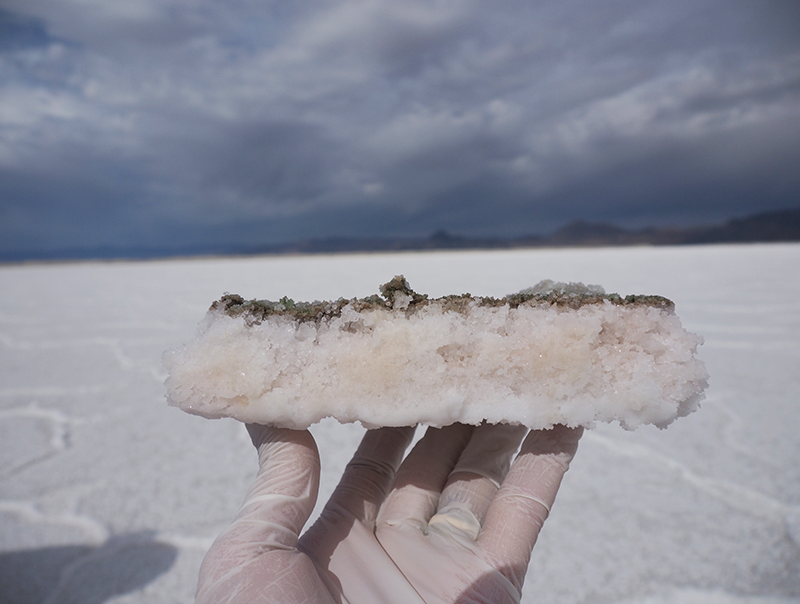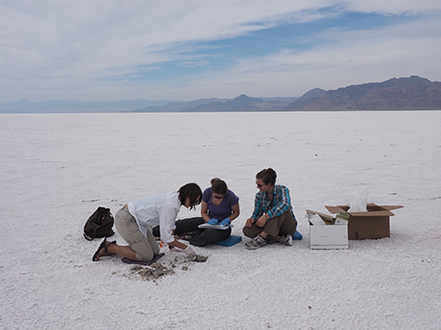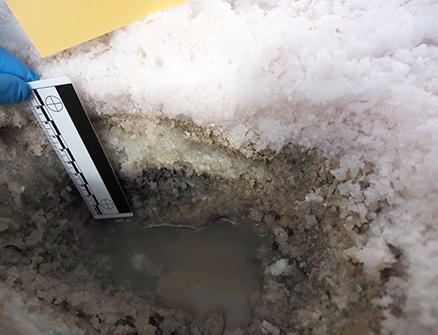
Bonneville Salt Flats

The Bonneville Salt Flats of Utah are famous for their other-worldly appearance and as a site where numerous vehicle land speed records have been set. Despite the sterile appearance of the salt flats, they host remarkably robust microbial communities that are visibly evident just below the top layer of crust.
Evaporite deposits such as the Bonneville Salt Flats are useful analogs for investigating the potential for ancient and modern life in saline conditions of extraterrestrial settings, including on Mars. Jezero Crater, the landing site for the Mars Perseverance Rover, contains sedimentary deposits expected to be the remnants of an ancient, now desiccated lake. Similarly, the Bonneville Salt Flats are the remnants of Lake Bonneville, the largest lake in western North America before it began to desiccate ~15,000 years ago.
Recent research at the Bonneville Salt Flats has been led by Brenda Bowen. This research has been highly interdisciplinary, including geology, microbiology, and sociology.
A scientist-artist collaboration by Brenda Bowen and Wendy Wischer produced this art exhibition about the Bonneville Salt Flats.
You can follow science-oriented updates about the Bonneville Salt Flats on Twitter.

Publications and data
The Brazelton lab has led the microbiological studies of the Bonneville Salt Flats, which have produced the following publications so far:
- The first whole-community survey of microbial diversity at the Bonneville Salt Flats, by Julia McGonigle et al. (2019).
- Metabolic pathways encoded by microbes in the Bonneville Salt Flats, by Julia McGonigle et al. (preprint).
Additional publications
- Bowen, B. B., Kipnis, E. L., & Raming, L. W. (2017). Temporal dynamics of flooding, evaporation, and desiccation cycles and observations of salt crust area change at the Bonneville Salt Flats, Utah. Geomorphology, 299, 1-11. HTML
- Kipnis, E. L., & Bowen, B. B. (2018). Observations of salt crust change from 1960–2016 and the role of humans as geologic agents at the Bonneville Salt Flats, Utah. In Geofluids of Utah (pp. 287-303). Geological Association. PDF
- Bowen, B. B., Bernau, J., Kipnis, E. L., Lerback, J., Wetterlin, L., & Kleba, B. (2018). The making of a perfect racetrack at the Bonneville Salt Flats. Sed Record, 16, 4-11. PDF
- Blacketer, M. P., Brownlee, M. T., Baldwin, E. D., & Bowen, B. B. (2021). Fuzzy Cognitive Maps of Social-Ecological Complexity: Applying Mental Modeler to the Bonneville Salt Flats. Ecological Complexity, 47, 100950. HTML
- Bernau, J. A., & Bowen, B. B. (2021). Depositional and early diagenetic characteristics of modern saline pan deposits at the Bonneville Salt Flats, Utah, USA. Sedimentology. HTML
- Radwin, M. H., & Bowen, B. B. (2021). Mapping mineralogy in evaporite basins through time using multispectral Landsat data: Examples from the Bonneville basin, Utah, USA. Earth Surface Processes and Landforms, 46(6), 1160-1176. HTML
- Sun, Y., O’Neill, L., Liu, M., DeLuca, K. M., & Bowen, B. (2021). Mobilizing the public in saving the bonneville salt flats: understanding blame as a psychological construct. Environmental Communication, 15(3), 301-319. HTML